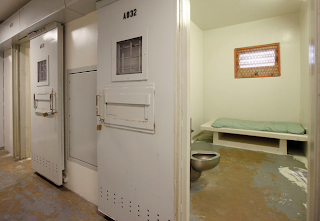Yeah – you read it right. What follows is the press release:
*****
The statement calls for the cessation of all hostilities between groups to commence October 10, 2012, in all California prisons and county jails. “This means that from this date on, all racial group hostilities need to be at an end,” the statement says. It also calls on prisoners throughout the state to set aside their differences and use diplomatic means to settle their disputes. The Short Corridor Collective states, “If personal issues arise between individuals, people need to do all they can to exhaust all diplomatic means to settle such disputes; do not allow personal, individual issues to escalate into racial group issues.” In the past, California prisoners have attempted to collaborate with the Department of Corrections to bring an end to the hostilities, but CDCR has been largely unresponsive to prisoners’ requests. The statement warns prisoners that they expect prison officials to attempt to undermine this agreement.
“My long-time experience in urban peace issues, gang truces, prevention and intervention, is that when gang leaders and prisoners take full stock of the violence, and how they can contribute to the peace, such peace will be strong, lasting, and deep. I honor this effort as expressed in this statement,” says Luis J. Rodriguez, renowned violence intervention worker and award-winning author of Always Running: La Vida Loca, Gang Days in L.A. Rodriguez has helped broker gang truces throughout the US as well as in other parts of the world. This spring, Rodriguez was involved in a historic truce between gangs in El Salvador leading to a 70% drop in violence in that country. According to Rodriguez, “What is needed now—and where most peace efforts fail—is the meaningful and long-lasting support of society and government, in the form of prison reform, training, education, drug and mental health treatment and proper health care. We need an end to repressive measures that only feed into the violence and traumas.”
Azadeh Zohrabi of the Prisoner Hunger Strike Solidarity Coalition sees the agreement as a positive development that stems from last year’s hunger strikes. “While living through some of the worst conditions imaginable, the authors of this statement continue to work for change,” states Zohrabi. “While the prison administration drags its feet on even the most basic reforms, these guys are trying to build peace throughout the system. That says a lot their humanity and hope.”
Advocates and the Short Corridor Collective are eager to spread the word as far and wide as possible and implement peace plans throughout California’s prisons and jails. “We must all hold strong to our mutual agreement from this point on and focus our time, attention, and energy on mutual causes beneficial to all of us [i.e., prisoners], and our best interests,” says the Collective. “The reality is that collectively, we are an empowered, mighty force, that can positively change this entire corrupt system into a system that actually benefits prisoners, and thereby, the public as a whole.” The PBSP-SHU Short Corridor Collective has strongly requested that its statement be read and referred to in whole. It can be found here.
*****
If this agreement will be respected by inmates in all CA institutions, it’s a major, major breakthrough. Interracial violence is often seen as a ubiquitous fact of life within walls. It also speaks volumes about the impact that the Pelican Bay hunger strike has had on organizing inmates, who are realizing that in order to end solitary confinement and debriefing they need to fight a common enemy, rather than each other. This is huge, and might hopefully bring CDCR to discard extreme incarceration practices if they cannot be justified as gang violence prevention measures.
———-
cross-published to PrawfsBlawg






